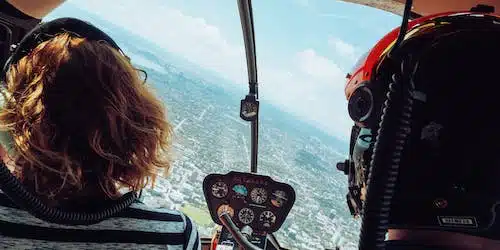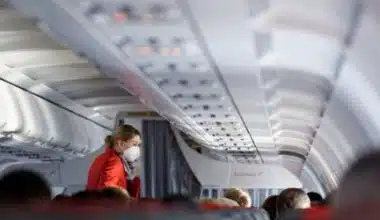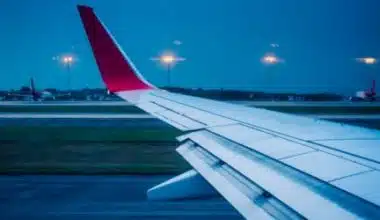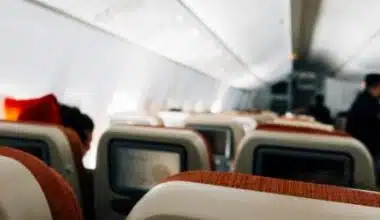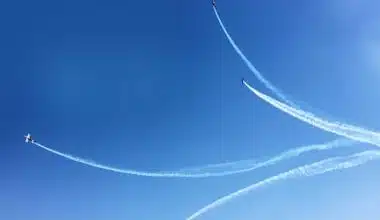Ever pondered the altitude at which a helicopter can fly? Perhaps you’ve considered becoming a helicopter pilot or have pondered whether a helicopter could soar over the clouds or save your life while you’re at the top of a mountain. Everything you need to know about the altitude and descent capabilities of a helicopter is compiled here.
How High Can a Helicopter Fly?
Rather than the rotor’s ability to create lift, the engine’s capacity to breathe thinner air determines the maximum altitude that can be attained during forward flight. Helicopters powered by turbines can fly up to 25,000 feet.
However, a high-performance helicopter can fly at 10,400 feet, which is substantially lower than the highest height at which a helicopter can hover.
The helicopter’s maximum hover altitude will be higher if it is hovering near a high point. A few helicopters have a 13,800-foot hover. For mountain rescue missions, this is helpful.
A 12- or 15-mile helicopter trip is the finest option if you want to feel the thrill of ascending to heights beyond 1000 feet; both provide the rare opportunity to truly appreciate the maneuverability of a contemporary helicopter.
How High Do Helicopters Usually Fly?
Helicopters typically fly at 10,000 feet, which is the ideal altitude for maneuvering. The air becomes thinner as the helicopter rises in altitude, meaning the blades must work harder to provide the same amount of lift.
The majority of helicopter pilots believe that 10,000 feet is the maximum acceptable flying altitude. The drag on the blades increases with altitude, resulting in a decrease in forward velocity and climb performance. The helicopter’s stability and maneuverability begin to decline.
Pilots and passengers are likewise at risk at high altitudes. Because there is less oxygen in the thinner atmosphere, aviation authorities mandate the use of oxygen masks at altitudes of 12,500 feet and above.
What Happens If You Try to Fly Too High in a Helicopter?
You should not attempt to fly a helicopter at a high altitude.
It’s unsafe to start with. A helicopter will begin to behave quite strangely at very high elevations. The helicopter starts to shake and rattle and becomes quite unstable due to turbulence. The pilot finds it challenging to maintain control of the aircraft under these circumstances. The engine will eventually fail due to power loss.
Furthermore, the blades may stall if the rotors lose lift. Additionally, the effectiveness of the tail rotor decreases, causing the helicopter to begin rotating.
As previously said, all of this happens because there are insufficient air molecules in the engine and rotors to provide the necessary power and lift. However, this will make the helicopter uncontrollable. Furthermore, for safe flying, the pilot must be able to operate the helicopter’s engine, main rotor, and tail rotor.
How High Do Police Helicopters Fly?
Police helicopters frequently need to maintain lower altitudes in order to patrol city streets and follow or look for suspects, even if they frequently fly at 10,000 feet over rural areas. Helicopters are not required by the FAA to operate at a minimum altitude. The organization does, however, advise staying above 1,000 feet while flying over cities.
Many law enforcement organizations, including police departments, abide by the FAA’s recommendations. From time to time, they might descend to obtain a clearer picture of the ground or to support ground units. Police helicopters frequently fly 500 feet or lower above sea level.
Police aircraft frequently have spotlights and thermal imaging technology installed. They can assist ground police in searching for suspects or policing an area around a crime scene by descending to a lower altitude.
What to Consider Before Flying
Before operating a helicopter, there are numerous weather-related factors to take into account. It is important to note not only the weather where you want to land but also the weather where you plan to take off. The weather may have an impact on any aspect of your flight.
Pilots ought to always think about:
#1. The Fall of Snow
Always think about the possibility of precipitation before taking off. Hail, snow, and rain can all increase the risk and difficulty of helicopter flights. Precipitation generally does not make flying more difficult, but it might make navigation more difficult. For example, it may be difficult to spot approaching hazards when flying through heavy weather. Furthermore, precipitation at your landing and take-off locations might increase the risk of accidents by making the surface slick.
#2. Humidity and Moisture
Although it might not seem like a big deal, humidity can significantly affect how well a helicopter performs. According to the FAA guidelines, several helicopter manufacturers provide a chart with a column for operating criteria in 80% relative humidity. Compared to performing in dry air, there is an approximate 3-4% drop in performance on average. Even though it might not seem like much, it is something to consider before departing, particularly when combined with other elements.
#3. Clouds and Fog
Like precipitation, fog and cloud cover can significantly affect navigation. Pilots normally have a harder time seeing through dense clouds and fog, while this usually has no effect on performance. Therefore, before taking off, landing, and throughout the flight, pilots should always take the fog and cloud conditions into consideration.
#4. Wind Direction
The FAA lists wind as one of the three most critical elements affecting flight performance, and with good reason. The wind’s direction and velocity can affect how well a craft hovers, takes off and climbs. Although they may also cause you to slow down, certain winds, such as headwinds, can actually improve your performance and reduce the amount of power your helicopter needs to hover. However, it may be more difficult to keep your direction under control when flying in the presence of crosswinds and tailwinds. This can be risky and necessitates greater effort from the pilot and the helicopter to stay on course.
#5. When Winds Are Too Dangerous
To help pilots recognize when winds are too dangerous to fly, some helicopter manufacturers offer a critical wind azimuth or maximum safe relative wind chart. Flying in strong winds can endanger a flight’s safety. Before taking off, always check the wind direction and speed.
#6. Lightning and Storms
Similar to flying airplanes, it is not advisable to operate helicopters during strong storms with lightning. While certain helicopters can land even after being struck by lightning, it might be risky to pilot a metal aircraft during a lightning storm. Most pilots won’t fly if lightning is expected, and lightning can still seriously injure a vehicle.
#7. Freezing Conditions
Helicopter flights in freezing weather can be quite risky, particularly in high-humidity circumstances. Both the inside and outside of the aircraft may develop ice, which could alter equipment performance and lead to control issues. Furthermore, in frigid weather, it is typically hard to fly through clouds.
If flying in freezing weather is required, antifreeze solutions could be useful. On landing bases, salt should not be used because it can get sucked into the engine and break it.
Helicopter Performance
The following variables affect the helicopter’s performance, assuming that the engine and all other parts are running smoothly:
#1. Air Density
Air is a fluid, just like other gases and liquids. It flows and changes shape under pressure since it is a fluid. High-altitude air is referred to as “thin” air because there are fewer molecules per cubic foot of air above 10,000 feet than there are at sea level. The air in a car tire squeezed to thirty pounds of pressure is not as “thin” as the air at sea level. A compressed cubic inch of air in a car tire has a higher density than a cubic inch of “free” air at sea level.
#2. Density Altitude
Density height is the term used to describe the theoretical air density at a specific altitude under typical conditions. At sea level, typical circumstances are:
- The atmospheric pressure is 29.92 inches of mercury (in inches).
- The temperature is 59°F, or 15°C.
At any higher altitude, standard circumstances are predicated on:
- Lower than sea level atmospheric pressure: 29.92 inches of mercury
- Temperature: 15°C (59°F) minus 2°C (3.1°F) for every 1,000 feet of elevation
#3. Altitude
The effects of height on air density were already covered in this chapter’s first part. An airport’s or landing area’s elevation directly correlates with atmospheric pressure, which in turn causes the air to be less dense. The density altitude increases with decreasing air density. What happens when you operate at a high altitude? The performance of helicopters is reduced. The density altitude chart shows that density altitude rises with increasing altitude.
#4. Atmospheric Pressure
At an airport or landing area, the atmospheric pressure can fluctuate daily at a specific height. This variation can occasionally be extremely obvious and, when combined with other factors, could have a substantial impact. The air density decreases with decreasing pressure at a particular elevation; hence, the higher the density altitude, the less performance the helicopter will have.
The daily and seasonal fluctuations of temperature and moisture will have a greater impact on the density altitude than the daily and seasonal variations in atmospheric pressure at a particular location.
#5. Temperature
Temperature variations will result in significant variations in air density, even in the case of constant elevation and pressure. When the temperature rises, the same volume of air that initially occupies 1 cubic inch will expand to fill 2, 3, or 4 cubic inches.
#6. Moisture
Variations in the air’s moisture content will alter the air density at constant pressure and temperature. Dry air weighs more than water vapor. Consequently, air gets less dense as moisture content rises; this causes density altitude to rise, which lowers helicopter performance.
Can a Helicopter Fly to the Top of Everest?
In a nutshell, the answer is yes; a helicopter can reach the summit of Mount Everest. Successful ascents to the peak of Everest have also been achieved via helicopter. Didier DelSalle reached the summit of Mount Everest in a plane in 2005.
Why Can’t Helicopters Fly at High Altitudes?
The air becomes thinner as the helicopter rises in altitude, meaning the blades must work harder to provide the same amount of lift. The majority of helicopter pilots believe that 10,000 feet is the maximum acceptable flying altitude.
How High Can a Jet Fly?
42,000 feet is the highest point that a commercial aircraft is permitted to fly since it is the maximum altitude that is generally recognized. It is referred to as the “service ceiling” for aircraft. Because flying at such a high altitude is known to maximize efficiency, most commercial air jets operate at this level.
What Is the Minimum Height a Helicopter Can Fly?
What is a helicopter’s minimum altitude? If flying over a city, the minimum height is 1000 feet; if not, it is 500 feet. Helicopters operating at low altitudes can be surveying or conducting aerial examinations of electrical cables. Also, medical transportation can be available.
Who Can Fly Higher Than Mount Everest?
The ability to fly is not a restriction for bumblebees when they are looking for new locations for their colonies.
Do Airplanes Fly over Mount Everest?
According to Tim Morgan, a professional pilot who writes for Quora, airplanes are able to go above 40,000 feet, meaning they can pass over Mount Everest, which is 29,031.69 feet high. Normal flight routes do not, however, pass over Mount Everest due to the harsh weather that the mountains cause.
Summary
In summary, there is a single, obvious reason why helicopters are unable to soar as high as fixed-wing aircraft.
They require more air than the height provides. They will either run out of fuel for the engine or run out of lift from the rotor blades if they attempt to go too high. These will be the elements that restrict a helicopter’s maximum altitude.
Naturally, these variables will change depending on the circumstances. Because of this, pilots typically refer to their helicopter’s manual to be safe. In order to prevent running out of power at the wrong moment, they also provide a margin of error.
Things are evolving, just as with any other machine. The power of helicopters is steadily increasing, and newer versions are performing better. One day, it might be feasible to soar considerably higher.
- THE BIGGEST MALL IN CALIFORNIA IN 2023
- The Ultimate Grand Canyon Helicopter Tour: A Bucket List Experience
- THE BEAUTIFUL MOUNTAINS IN CANADA: Facts & History
- CHEAP BUSINESS-CLASS FLIGHTS IN 2023
- WHY ARE AIRLINES CANCELING FLIGHTS?
